Claustral Canyon is a canyon I have visited a lot of times. It is one of my favourites and it is one that I have tried photographing many times over the years. The trouble is that on a normal trip through the canyon, it is not fair to hold up other party members too much in the time spent setting up tripods and pfaffing around with cameras.
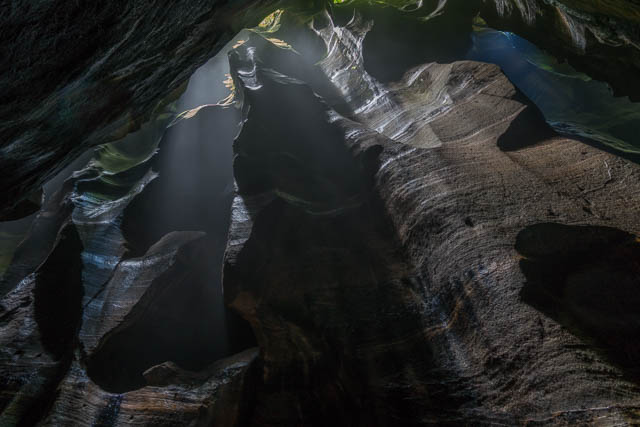
So it was good that Albert was keen to come along on a photographic trip through the canyon.
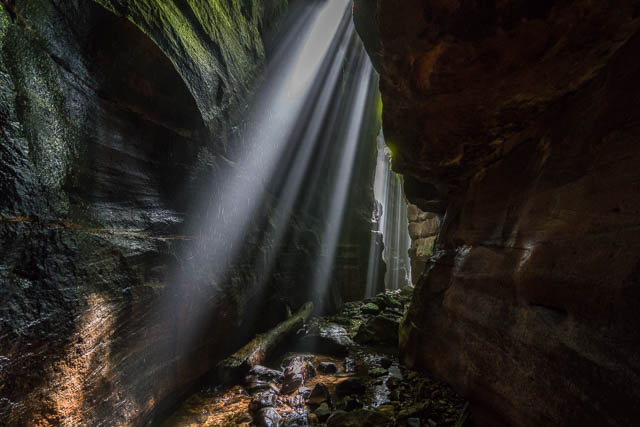
Claustral Canyon was the first sandstone I ever visited (apart from the Grand Canyon tourist track at Blackheath as a kid), and it left a very deep impression on me. I never imagined places like that existed. This was perhaps a principal motivation to do some exploratory canyoning – an aim being “to find another Claustral Canyon”. I never succeeded in this, but I was on trips where we found some nice canyons in their own right. Also, Claustral Canyon involves some technical skills like abseiling down waterfalls and climbing out via tricky scrambles, so it is perhaps not a place that everyone can visit. But everyone can look out photos and it would be nice for people unable to visit the canyon to at least see it vicariously and appreciate its splendour and beauty.
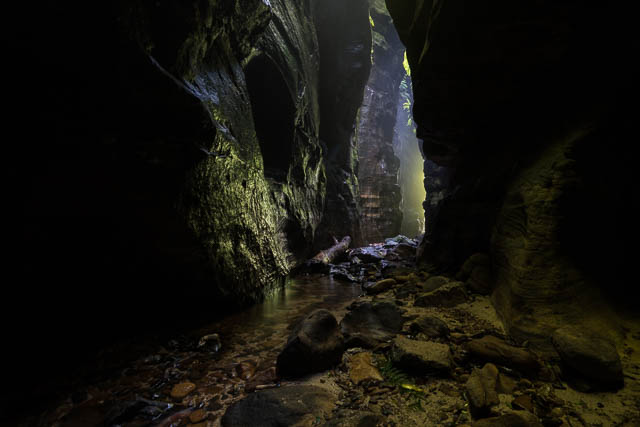
All parts of the Claustral Canyon are very spectacular and lend themselves to photography. On this trip, we set out to get photographs of the most constricted part from the bottom of Calcutta Falls (The Black Hole of Calcutta) to the junction of Thunder Canyon. At that point Claustral Canyon ends and flows into Thunder Gorge.
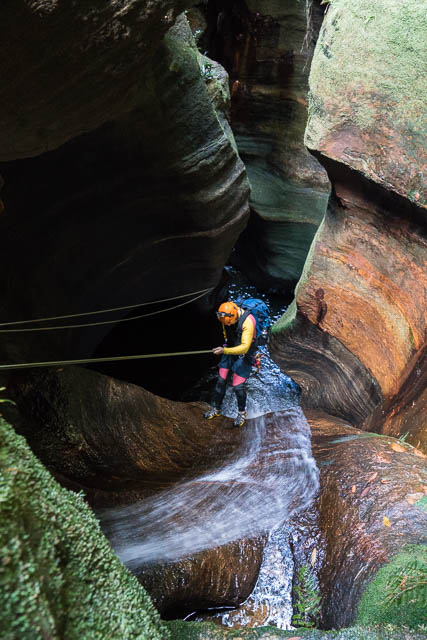
The history of these canyons is interesting. It is unlikely that they could have been explored by aboriginals as ropes are needed to access them, and it is very difficult to climb up through Thunder Gorge from below. Above the canyons are plenty of signs of aboriginal occupation – e.g. sharpening grooves on the Camels Hump and near the old track up Mt Tomah, but there is no art in caves in the canyon as far as I know.
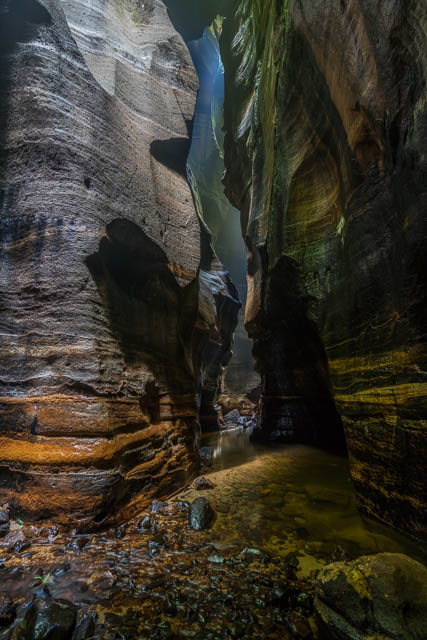
The first of the canyons in the area to be visited was Thunder Canyon, by a small party led by Col Oloman from Sydney University Bushwalkers back in October 1960. That trip has been well documented in the SUBW archives (and see here and here). Not long after, more SUBW parties visited Thunder Canyon, but I have no evidence that they travelled up Claustral Canyon at the junction despite it being an easy walk for a long way. Perhaps this was because Thunder Canyon looks by far the better canyon at the junction (and indeed Thunder Canyon is a deeper, darker and narrower canyon, but it is far shorter than Claustral).
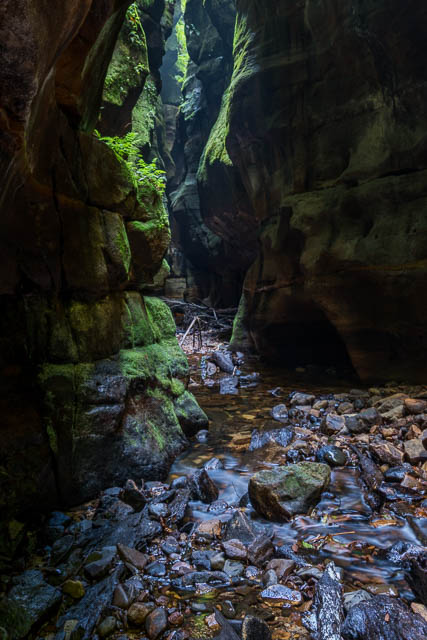
It was not until April 1962, that a party visited the next canyon in the system – Ranon Canyon. This was a small party from the Kameruka Bushwakers – Barry Dunnet and Dave Lambert. After descending Ranon Falls, they arrived at the junction with Claustral Canyon and made their way up what was later called the Black Hole of Calcutta. They were amazed with what they saw and probably swam up to the base of the last waterfall. Barry Dunnet returned next summer with a party on a trip to explore Claustral Canyon from above. This was around December 1962. They reached the abseils and descended the first two drops. Logs and a jammed stump provided belay points. At the third drop – the Keyhole Chamber, the keyhole was blocked at the time, and there was no belay point. So the party were forced to climb back up their ropes and climb out of the canyon. Later, on the same trip, they descended via Rainbow Ravine to Thunder Gorge and managed to climb up all the small drops and reverse the canyon right up to the bottom of the abseils.
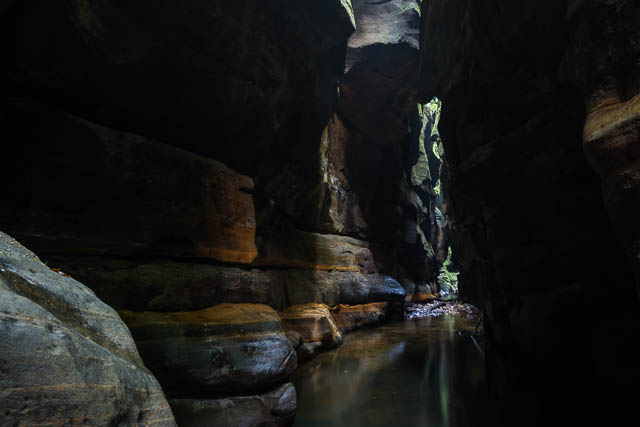
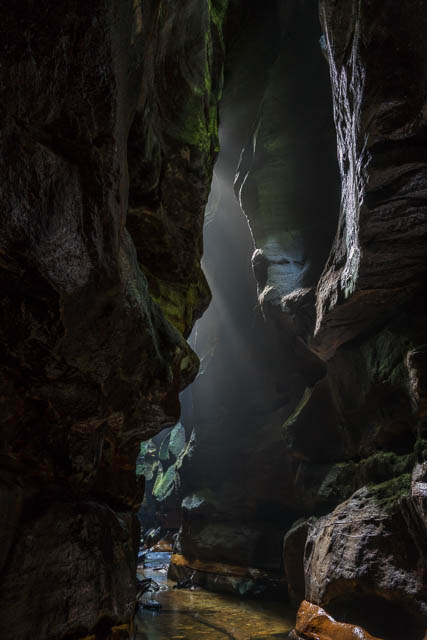
Another Kameruka party, later returned to Claustral in 1963, and placed a bolt at the top of the third abseil and used that to descend – making them the first party of complete all the abseils. But, before that party, a small party from University of NSW Bushwalkers, Rick Higgins and Terry Thomas, had descended right through the canyon, but via an unusual route. They got to the waterfalls and climbed around on a ledge to the true right and then abseiled directly into the canyon. Rick completed an abseil and Terry called out if he could see anything. Rick replied “its the Black Hole of Calcutta!”. Two abseils took them to the canyon floor. They called the canyon Calcutta Canyon. The canyon name was later resolved to everyones satisfaction at the next meeting of the Federation of Bushwalkers, where the Kameruka name for the canyon was adopted – Claustral Canyon, and the waterfalls were named Calcutta Falls.
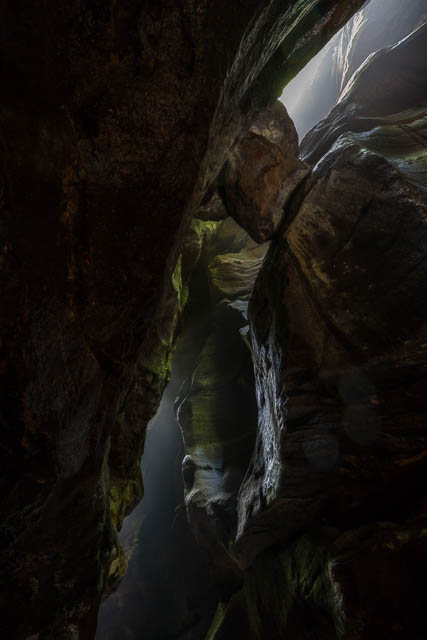
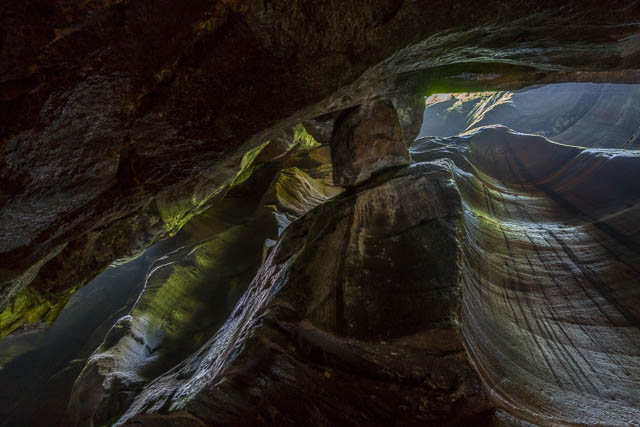
Recent access changes to the canyon have resulted in a much shorter way into the canyon from the Bell Road near Mt Bell. From the car it now takes about 60 minutes to reach the abseils. It took about 2 hours via the old route from Mt Tomah (but the exit from the canyon is now a bit longer). This means that many people now visit the best bit of the canyon fairly early in the day, well before the best lighting conditions. Early in the day the canyon is dark and gloomy. It probably is best around noon to 2 pm. Perhaps because of its closeness to the high peak of Mt Tomah with its own weather, and nearby rainforest, Claustral Canyon seems to get more sunbeams than many other similar canyons such as the Grand Canyon at Blackheath. Or it could be due to the orientation of the canyon? These sunbeams are wonderful in the canyon and a joy to photograph.
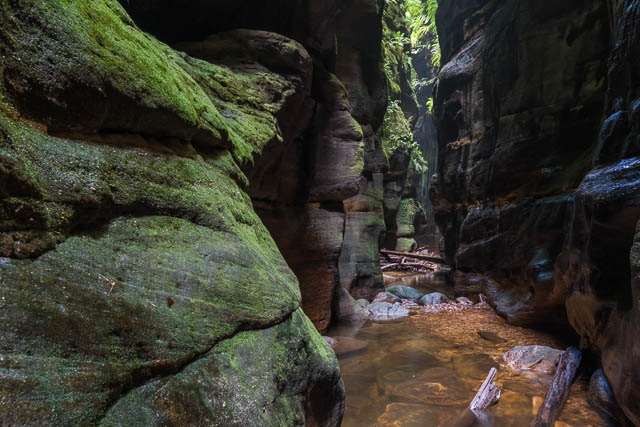
On this trip, we were fortunate to have some nice sunbeams entering the canyon. But we only encountered them because we were prepared to spend a fair bit of time in the canyon. Looking at the EXIF data from my photos, it looked like we spent about 3 hours, from 11:15 am to 2:15 pm taking photos along this section of the canyon.
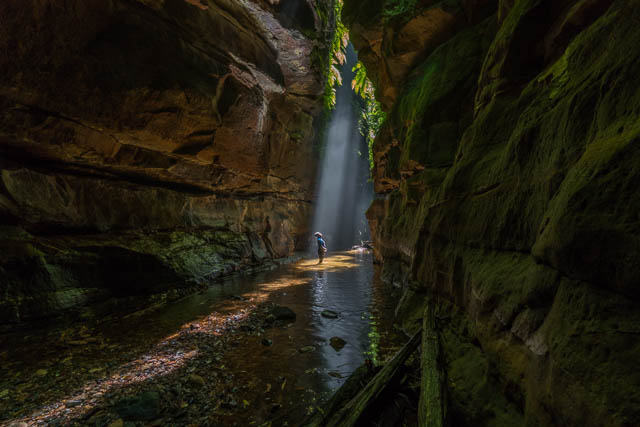
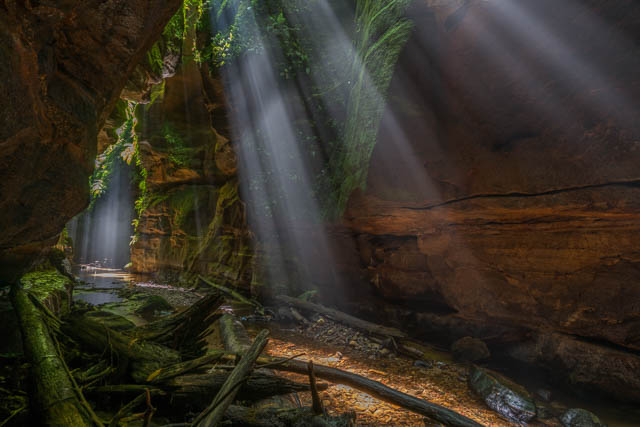
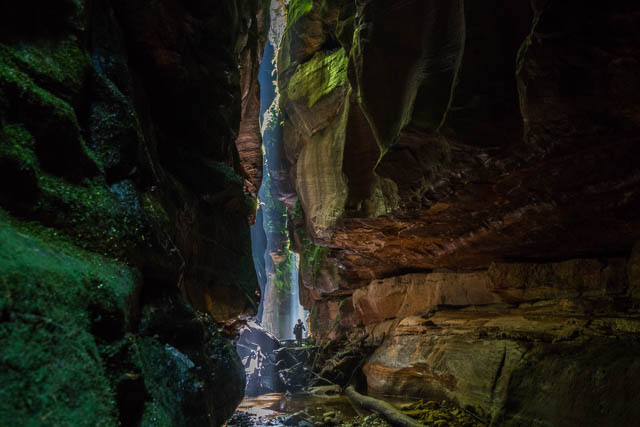
Both Albert and myself used full frame cameras and tripods. I took single shots and most of Albert’s shots were 3 bracketed exposures that he will later merge to increase the dynamic range. One problem with canyon photography is the dynamic range. Parts of the canyon lit by direct sunlight tend to result in blown out highlights that are impossible to correct in post processing. I try, with my photography to avoid photographing areas that will be burnt out. This is difficult however if you want to capture the canyon with sunbeams entering it. Perhaps the best time is during misty weather – post rain, when the sun starts o come out and then the lighting can be quite soft. On this trip, the lighting was quite harsh and many photos were later discarded. But that left some photos that were quite reasonable.
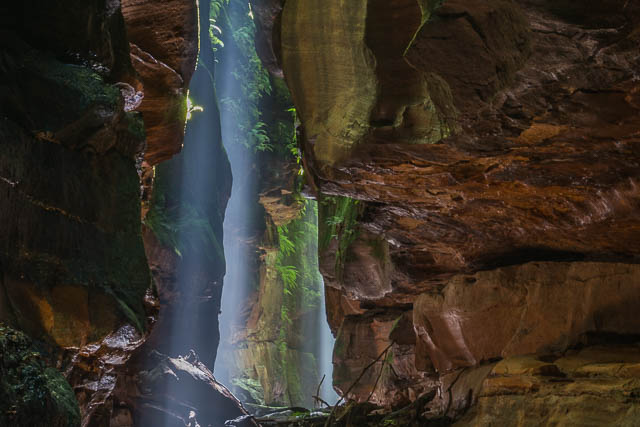
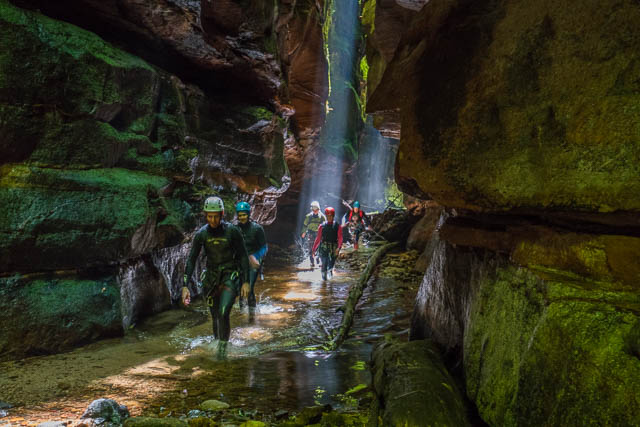
Other problems with canyon photography are getting droplets of water on the lens, condensation on the lens from the high humidity, focusing in low light and keeping your camera dry. The last of these problems is not so bad in Claustral as there is only one swim after the Ranon Junction,and that is right at the start (and a little further on there is deep pool where the camera should be waterproofed as you walk along a log to avoid a swim), but after that only wades, so the camera and tripod can be kept out handy.
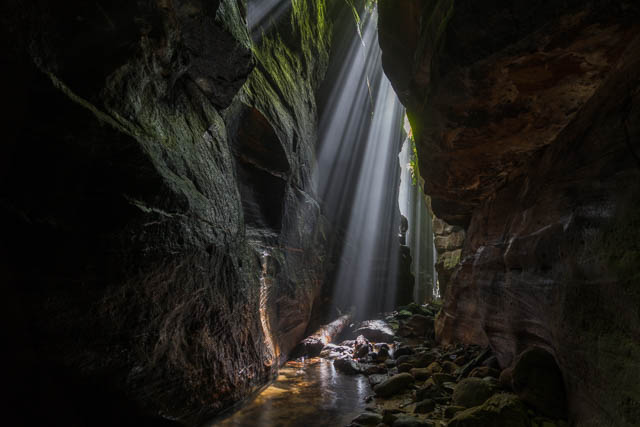
Sometimes in a canyon, I have got so cold by not being very active when taking photos that my fingers get too numb to work the camera controls. That was not a problem this day. The day was warm and the canyon water about as warm as it gets.
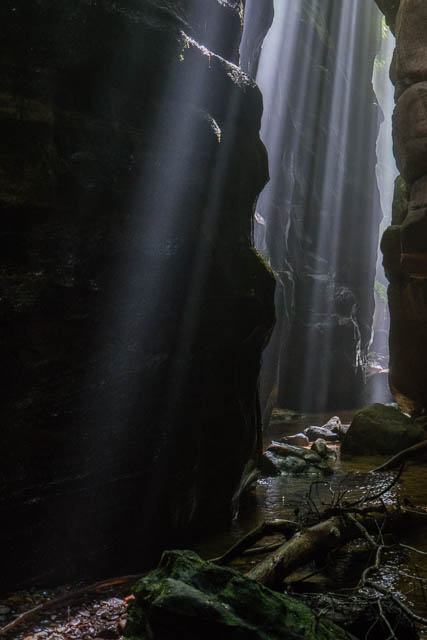
After all our photography, we quickly set off down Thunder Gorge for the exit up Rainbow Ravine. We had a late lunch high up in Rainbow Ravine and then climbed up to the Camels Hump before crossing the causeway and dropping back into the creek for the walk down to the entrance/exit gully.
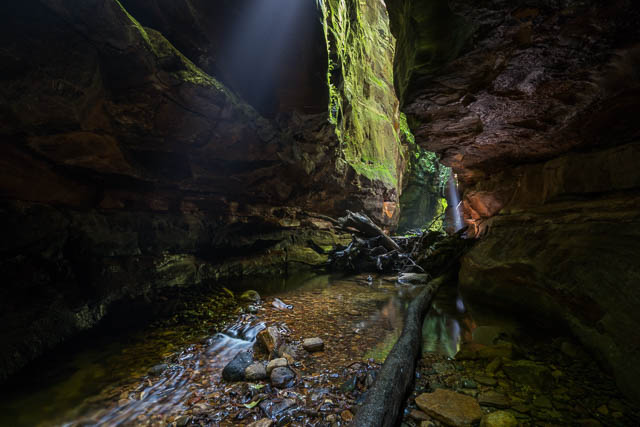
If contemplating a photographic trip to the canyon it is advisable to be familiar with it and know roughly how long each section takes to traverse. A decent camera and tripod can be quite heavy – so it is good to cut down on other weight if you can. Eg – Don’t carry along a heavy rope. A 25 m rope is sufficient for the canyon.
More photos from the trip are online on my website here.

your photos here are fantastic!